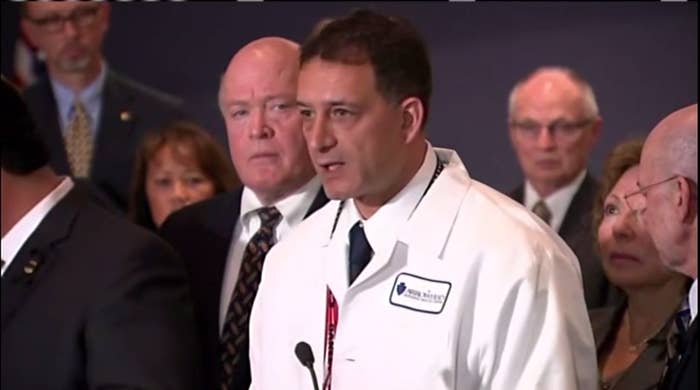
As San Bernardino’s SWAT team entered Inland Regional Center on Dec. 2 after two shooters opened fire on a room of county workers, they had in tow a special member at the end of their contingent — a trauma doctor.
Dr. Michael Neeki, a trauma physician at Arrowhead Regional Medical Center in Colton, is a rare breed of doctor trained to treat the wounded under war-like conditions.
As more mass-shootings involve bullets designed for military-style assault rifles, doctors with this training carry specialized skills to respond to injuries that require advanced life-saving techniques beyond treating a typical bullet wound from a handgun. They rush into dangerous situations all in an effort to care for an injured SWAT member and treat the wounded.
"They will take a bullet for me and I will take a bullet for them," Neeki said in a press conference on Monday. "I'm honored to be a physician working in this county."
Neeki drove to the scene in his own car carrying his own tactical equipment as soon as he heard reports that shots had been fired at the center.
By the time he arrived at the building, the situation was still active and had been converted into a hostage rescue. Neeki was the sixth person at the end of the SWAT team and held a rifle as the group snaked through the building.
The day of the attack on Inland Regional Center, Neeki was the first doctor to face dozens of serious head and chest injuries. Twenty-one people had been injured in the carnage, which claimed the lives of 14 people.
“They didn't have a good chance of surviving,” Neeki told WMTW. “We are very sad. There is no good news when you find out that your fellow citizens have died for no good reason."
Medics in a training led by the International School of Tactical Medicine based in Rancho Mirage, California.
All SWAT teams are trained in basic trauma medicine and carry a first aid kit to respond to critical injuries, Jim Morrissey, a paramedic with the Alameda County Emergency Medical Services in California and a SWAT medic in San Francisco, told BuzzFeed News. But tactical medics are specially trained to assess a range of life-threatening injuries and prioritize patients with critical wounds.
This skill becomes increasingly more relevant as the country continues to deal with mass shootings involving assault rifles and specialized bullets, said Morrissey.
“Events like San Bernardino or Paris are kind of different,” he said. “They’re not typical active shooters. They typically have multiple weapons. They’re not afraid to die. It’s a real game changer.”
Neeki, an Iranian immigrant, is no stranger to trauma wounds found on the battlefield. He was a political opponent to the Iranian regime when they took over in 1979 and served two years in the Iran-Iraq war where he was first trained in tactical medicine.
He was one of the only doctors allowed to go into the area of the Inland Regional Center shootings because of his training which was largely accomplished because of self-initiative, he told reporters.
“I’m trying to bring attention to this need because it’s not going to be the end of the story,” he said. “We are trying to bring something in a positive direction.”
